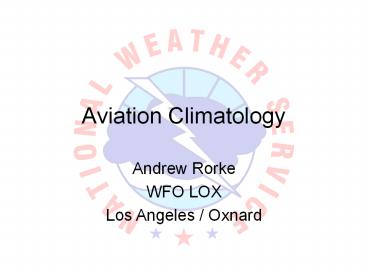Aviation Climatology - PowerPoint PPT Presentation
Title:
Aviation Climatology
Description:
A database of observations for a given TAF site ... Use a database program such as Filemaker Pro. Use the database to search and sift the data ... – PowerPoint PPT presentation
Number of Views:215
Avg rating:3.0/5.0
Title: Aviation Climatology
1
Aviation Climatology
Andrew Rorke WFO LOX Los Angeles / Oxnard
2
What Is Aviation Climatology
- A database of observations for a given TAF site
- The database contains Ceiling, Visibility, Wind
Speed and Wind Direction data for every day and
hour for (hopefully) the past 30 years.
3
What Good Is Aviation Climatology?
- Given a fairly normal climatological day,
climatology is probably the best forecast tool
for ceiling and visibility changes. - For any given ceiling and visibility aviation
climatology will produce a cig/vis forecast for
the next 1 to 6 hours.
4
Drawbacks of Aviation Climatology
- The day has to fairly normal.
- There has to be low ceiling (040 AGL or less) or
a low visibility (5SM or less) - It does not predict good flying weather turning
to bad flying weather - It does, however, predict, bad weather getting
worse
5
Aviation Climatology in the NWS
- Consists of two programs
- Ceiling and Visibility Distribution
- Determines how normal the day is
- Ceiling and Visibility Trend
- Forecasts changes in Cig and Vis based on current
conditions and climatology
6
Ceiling and Visibility Distribution
7
Ceiling and Visibility Distribution
8
Ceiling and Visibility Distribution Visibility
9
Ceiling and Visibility Distribution Joint Ceiling
and Visibility
10
Ceiling and Visibility Trend
11
Ceiling and Visibility Trend
12
Ceiling and Visibility Trend
- Pick The TAF Site
- Pick the Element
- Visibility only
- Ceiling only
- Joint (combined to flight cat)
- Chose the number of hours ahead to forecast
13
Ceiling and Visibility Trend
- Chose a range of dates to pull data from
- Smaller range might be more accurate, but might
not sample low frequency events - Defaults to /- 30 days from current
14
Ceiling and Visibility Trend
- Choose your start hour for initial conditions
- Default may be too much try to use 1 or 2 hours
15
Ceiling and Visibility Trend
- Enter the wind information
- Again a smaller range will be more accurate
provided there is enough data to sample
16
Ceiling and Visibility Trend
- Enter the Ceiling and Visibility information
- Unlike this example try not to cross flight
categories
17
Ceiling and Visibility TrendThere Must Be An
Easier Way!
18
Ceiling and Visibility Trend
19
Ceiling and Visibility Trend Results
Vis Only VFR is inferred Count refers to
total data points
20
Ceiling and Visibility Trend Results
Cig Only VFR is inferred Count refers to
total data points
21
Ceiling and Visibility Trend Results
Both Cig and Vis VFR is inferred Count refers
to total data points Note that the data points go
down
22
Ceiling and Visibility TrendSummery
- A great forecast tool when properly used.
- Best for predicting burn off or changes to a
pre-existing ceiling or fog obscuration - Works best during normal conditions
23
Aviation Climatology In The Southwest
- Ceiling based Aviation Climatology is not ideally
suited for the Southwest - The vast majority of Ceiling and Visibility
restrictions occur on the coast - Aviation Climatology gives very little
information on arrival times of lower flying
conditions - Aviation Climatology does not make wind
predictions (important to many SW airports)
24
KLAX Los Angeles International
- Concerns
- Ceiling Visibility Arrivals
- Ceiling Visibility Changes
- Ceiling Visibility Improvement
- Sea Breeze Front
- East Winds
- Traditional Climatology only helps with 2 of the
five problem areas
25
Need To Look For Something New
26
Pressure Gradient Aviation Climatology
- Stratifying the observational data base using
pressure gradients. - Would generate wind forecasts
- Would give information on ceiling and visibility
arrivals - Initially it might provide information on not
events, but hopefully when combined with other
information will be able to provide arrival
forecasts.(KPRB combined with KSNS ceiling info)
27
Pressure Gradient Aviation Climatology
- Which Gradient Values to use?
- Must be chosen for each TAF site
- Look At
- The Current Gradient
- The 24 hour Change
- The 12 hour Change (how different is it from the
normal diurnal change) - The 3 hour change
28
Pressure Gradient Aviation Climatology
- Calculate these gradients and trends and link
them to their corresponding observational values - Use a database program such as Filemaker Pro
- Use the database to search and sift the data
- Use the databases GUI creation capabilities to
design a front end for the aviation desk
29
Pressure Gradient Aviation Climatology
- KLAX
- KPRB
- Use LAX-DAG and LAX-BFL
- Good with not forecast of sea breeze front
- Good with east wind forecast with rain
- So-so results with summertime east winds
- Use SNS-PRB and SFO-SBA
- By itself good with no cig forecast
- Needs to be linked with current conditions at
KSNS for better arrival time forecast
30
Questions?
- Andrew Rorke
- andrew.rorke_at_noaa.gov































